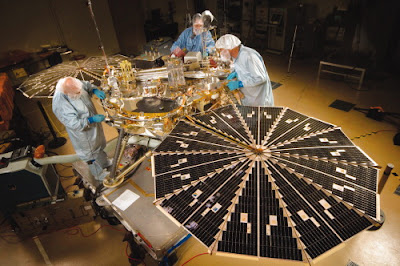I would note that the basic science of stealth originates same Russian mathematics paper of the mid-1960s as it always had, so my money is on anti-Stealth in the medium term.
Radar Threatens Stealth (Subscription Required)
Aviation Week & Space Technology
06/18/2007, page 132
David A. Fulghum
Washington
The debate continues over whose black projects are most effective
Printed headline: Stealth Rules
The stealth versus radar contest is making another of its periodic swings–this time in favor of new, advanced radars. But stealth specialists say it won’t be enough because stealth is improving even faster than the radars.
There’s a new generation of stealth on the way that will be seen in the F-35 Joint Strike Fighter and the Navy’s new Unmanned Combat Air System. It will provide protection against high-frequency radars traditionally associated with advanced air defenses. But stealth designs will also be tuned to evade low-frequency radars that can detect older stealth designs like the F-117.
Meanwhile, advanced radars are being developed by the U.S., France, Britain and Russia, with Moscow expected to share the technology with the Chinese military. The active electronically scanned array (AESA) radars are made up of thousands of efficient transmitter/receiver modules that produce a versatile, long-range radar. The F-22’s radar, which measures about 2 X 3 ft., has an estimated range of about 125-150 mi. The MP-RTIP radar–designed for the E-10 with a 4 X 20-ft. antenna to counter stealth–would have had an estimated range of perhaps 300 mi. or more. U.S. officials hint at ground-based radars with even greater ranges. It’s known that Israel’s Green Pine AESA radar is big and powerful enough to watch missile tests in Syria and Iran.
Even more intriguingly, if all the beams can be focused on a single spot–perhaps an enemy cruise missile, radar or a headquarters packed with computers–an electronic spike of electricity can be produced large enough to blind sensors, fill them with false targets and scramble computer memories. Raytheon has already tested an air defense system that uses radar transmitters to shoot down shoulder-fired air defense missiles.
Perhaps best of all for the U.S., researchers discovered how to take the products of electronic warfare effects generators and pump them through AESA radars on fighter aircraft–in particular, the latest F/A-18E/F and EA-18G models. That means electronic effects, such as false targets and other misleading data, can be fired as a data stream into the radars and other sensors of other aircraft, missiles and air defense arrays at ranges of a 100 mi. or more, farther than air-to-air weapons.
Air Force officials hint that the capability also exists in the F-22.
“We’re rapidly finding out the things the F-22 brings and how to use them,” says Lt. Gen. Chip Utterback, commander of 13th Air Force. “We are soon to integrate the F-22 and the [Marine Corps AV-8] in ways I would never have imagined. I’m talking about a joint team for a Harrier and an F-22 using the low observability of the F-22 and the ability of the AV-8 to identify and work targets while close to the ground–and while under a high-threat surface-to-air environment. We can put an F-22 in that environment and work some magic . . . in the electronic attack arena where we couldn’t before. With F-22, we can work our conventional forces much more aggressively in a high-threat area.”
Another clue comes from a longtime Pentagon stealth and radar specialist.
“The combination of the F-22’s stealth and electronic attack capabilities allows it to play both sides of the equation by being hard to detect and carrying the capability to generate false targets and jam enemy radars.”
This X-45C tailless flying wing represents the fourth generation of stealth that protects against detection by low-frequency radars as well as it does against traditional high-frequency air defense sensors.Credit: BOEING
….








